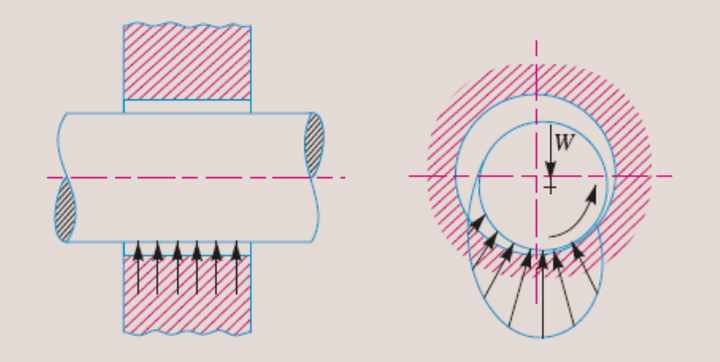- Home/
- GATE MECHANICAL/
- GATE ME/
- Article
Sliding Contact Bearing
By BYJU'S Exam Prep
Updated on: September 25th, 2023

Let’s start with a basic understanding of bearings before diving into the specifics of sliding contact bearing. Bearings are “components that aid in the rotation of objects.” They provide support for the rotating shaft within the apparatus. Automobiles, aeroplanes, power generators, and other machines need bearings. Sliding contact bearing can even be found in commonplace household goods like refrigerators, vacuum cleaners, and air conditioners. Bearings help the wheels, gears, turbines, rotors, and other rotating shafts of those devices to rotate more smoothly.
The most straightforward sort of bearing is a sliding contact bearing, which consists solely of a bearing surface with no rolling parts. As a result, the journal (the section of the shaft that makes contact with the bearing) glides across the bearing surface. A shaft revolving in a hole is the most basic example of a plain bearing. A primary linear bearing is a pair of flat surfaces that allow movements, such as a drawer and the slides it rests on or the ways on a lathe’s bed. Let’s take a deeper look at sliding contact bearing and its benefits and drawbacks.
Download Formulas for GATE Mechanical Engineering – Machine Design
Table of content
What is Sliding Contact Bearing?
Journal bearings, sleeve bearings, and plain bearings are all terms for sliding contact bearings. This bearing is typically used for shaft slides that are put over the bush surface and cause friction or wear. The revolving surface has been separated by lubricating fluid to reduce friction.
Sliding Contact Bearing Definition
The sliding in sliding contact bearings occurs along the contact surfaces between the moving and immovable elements. Plain bearings are another name for sliding contact bearings.
A particular metal, such as white or bronze, is also used to create the bush. Sliding bearings are also divided into two varieties, each dependent on the lubrication used in sliding bearings. Hydrodynamic-lubrication bearings and Hydrostatic-lubrication bearings are the two types.
A hydrodynamic bearing is a type of bearing that relies on a thin film of oil to create enough space for the spindle to rotate freely. Journal bearings are the most basic hydrodynamic bearings. Hydrostatic bearings, on the other hand, work on the principle of a sliding surface, in which a pressurized fluid, such as oil or any other type of lubricant, or air, is used to create a gap between two surfaces, allowing both rotating parts to move freely.
Download Formulas for GATE Mechanical Engineering – I C Engine
Sliding Contact Bearing Diagram

Classification of Sliding Contact Bearing
Slipper or guide bearings are sliding contact bearings in which the sliding movement is guided in a straight path while carrying radial stresses. These bearings are commonly seen in steam engines’ cross-heads. Journal or sleeve bearings are sliding contact bearings that slide around the circumference of a circle or along an arc of a circle while carrying radial stresses. Sliding contact bearings are classified into the following categories.
- Based on the type of load carried
- Based on the type of lubrication
- Based on the lubrication mechanism
Bearing Classification Based on Type of Load Carried
According to the direction in which the load is applied, three basic types of loads operate on sliding contact bearings as follows.
- Radial bearings
- Thrust bearings or axial bearings
- Radial – thrust bearings.
Bearing Classification Based on Type of Lubrication
In a shaft bearing combination, the kind of lubrication refers to how much the contacting surfaces are separated. This classification of Sliding Contact Bearing based on type of lubrication contains the following:
- Thick film lubrication
- Thin-film lubrication
- Boundary lubrication
Download Formulas for GATE Mechanical Engineering – Industrial Engineering
Bearing Classification Based on Lubrication Mechanism
Lubrication is vital to any spinning equipment’s efficiency and life expectancy. Lubrication decreases friction, allowing moving machine parts to flow past each other smoothly. There are various types of lubrication mechanisms, as shown in the list below.
- Hydrodynamically lubricated bearings
- Hydrostatic lubricated bearings
- Elastohydrodynamic lubricated bearings
- Boundary lubricated bearings
- Solid film lubricated bearings
Advantages and Disadvantages of Sliding Contact Bearing
The shaft glides across the bush’s surface in this type of bearing, causing wear and friction. A thin film of lubricating oil separates the rotating surfaces to reduce friction. Sliding contact bearings have several advantages and disadvantages compared to rolling contact bearings. which are listed below.
The advantages of Sliding Contact Bearing include:
- A simple bearing and housing design.
- They are more compact and take up less radial area.
- They are less expensive.
- The shaft has a simple design.
- They are more silent in operation.
- They can withstand a lot of shocks.
- They are well-suited to operations at medium and high speeds.
The following are the disadvantages of Sliding Contact Bearing:
- Frictional power loss is more significant.
- They necessitated careful lubrication.
- They’re usually made to carry solely radial or axial loads.


